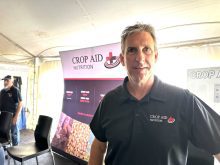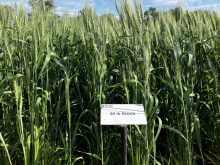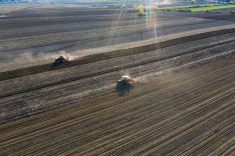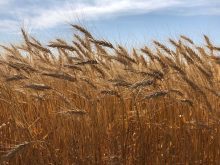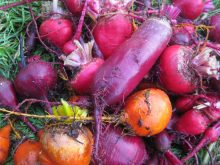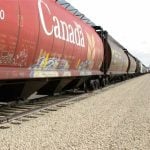It was an idea that started with literal garbage, but today an east-central Saskatchewan farmer hopes to use pelletized compost as supplementary fertilizer.
Kyle Heggie has been spreading a unique blend of compost on his crops for years. He’s also used on-farm trials to test the practicality of mid-row banding compost “pellets” into the seed row next to the seed. He hopes to do this in an actual crop situation this spring.
“We have some compost ready to go,” says Heggie, who farms with his brother Joel and dad Rob near Leross, Sask., about 100 km west of Yorkton.
Read Also

Claas brings 1000 Series SP forage harvesters to Canada
In mid-August, Claas unveiled its new line of Jaguar forage harvesters at an event in Visalia, California, deep in the heart of that state’s dairy region.
“So now once these compost rows warm up, we’ll start trying to dry them down by turning them to get them into the proper moisture for pelleting. Then it’s screening, and then we start pelleting.
“So hopefully this spring we can get some on some acres.”
Planting the pellets takes place on the same seeding pass as the seed and conventional fertilizer by using an unused tank mounted on the seeder and a seed drill to place the pellets with precision.
“We’ll be metering 100 lbs. of compost pellets into the same seed row with everything else,” Heggie says.
Trial and error
The Heggies are pedigreed seed growers with a focus on pulses, cereals and oilseeds.
Kyle Heggie had a lightbulb moment about five years ago when he saw how in-demand dust, screenings and weed seeds — garbage, essentially — from his father’s seed-cleaning operation could be.
“It was just a filler, no real nutrient value in it for cattle. But cattlemen would take a tandem load at a time,” he says.
“We’d take it out to their pasture and dump it off, and the cows would mow through most of it, roll in it, eat some.”
This inspired Heggie to talk to his dad about composting the byproducts to use as a nutrient source for crops.
“We had this byproduct sitting there. And I just mentioned we should just try composting: ‘Let’s just do a little run of something. It doesn’t have to be fancy.’”
The search for the right compost “recipe” was one of trial and error, Heggie says.
“We didn’t know anything; we were really green. We thought we had to add more nitrogen to it. So we had some alfalfa land (with) alfalfa bales. We thought, ‘Oh, geez, that’s a really good nitrogen source.’”
They soon found out the bales created too much N. “We realized that you don’t need that much nitrogen to make compost,” he says.

The project shifted into high gear after Rob took a class on composting.
“He came back with even more knowledge of building a compost program, to where you get more fungal compost to bacteria-based. And it’s way over my head.
“That’s pretty much how it just slowly, gradually got bigger and bigger, to where we bought the equipment to turn and compost.”
The process
The Heggies use a compost turner in a windrow to turn the ingredients — water, carbon and nitrogen ingredients, wood chips and a wide range of baled straw types including rye, flax, oat and barley — into compost.
After a while this movement heats up the mixture and in the process kills undesirable material like weed seeds, pathogens and oat screenings.
The process has gotten very scientific; Rob is able to calculate how much carbon and nitrogen are in the compost in order to target specific nutrient goals.
Kyle estimates the nitrogen and phosphorous at 22 lbs. each, or about one per cent of a tonne.
It may not sound like a lot but the abundance of organic matter in the compost cocktail also helps, he says — not to mention its water-holding capacity.
“It’s amazing how much water you can put in (the compost) and so I’m hoping down the road by just continuously either spreading it or putting it in the seed row, we are now going to hold onto more water for our springtime melt on the land.”
Once the composting is done, the mixture is spread on a field. “It’s just broadcasted like you would broadcast fertilizer on your lawn with a little spreader.”
But these days, composting is just the start of the procedure. To get the most from the nutrient-rich compost, they decided to place it right next to the seed. “How do we do that? You got to pelletize it. And that’s where we’re at now.”
They procured a pelleter from Manitoba originally designed for turning hops into pellets for breweries. The machine applies constant pressure until it creates the desired pellet size. They come out of the machine very hot, Heggie says.
“I think the compost was going in at about 10, 12 C. But once it went through the pelleting process it was up to about 35 C. So now you’ve got something that’s hot and wet and you got to cool it.”
They have not yet got the cooling process down to an art, but the plan is to put the pellets in bins with aeration and fans “just like we’re cooling the grain down in the fall.”
The pellets are dried by placing them in the back of a grain truck and — given the small volume of pellets they’re using — that’s probably where they will continue to be dried.
“It’s not like we’re doing 10 tonnes an hour. We’re only going to be doing two tonnes a day with this so it’s not going to be large volume. I think a lot of it will just dry off itself going into the grain truck.”
Management puts pellets in their place
So has Heggie seen increased yield in his pellet trials? Not yet, but he has an idea how it will.
An agronomy company has separated the farmland into zones for variable rate farming. Zone 1 has the lowest organic matter and possible soil salinity, while Zone 10 features his best soil.
This gives Heggie an idea of which zones need the most fertility.
“So I’m looking at the Zone 1 and Zone 2 and being like, ‘OK, these are problem areas. These are the areas where maybe there’s only 10 acres and a quarter or 20 acres and a half section, but those are the problem areas that I need to get producing more to bring up my total average.
“There’s an eroded hill that was cultivated for the last 40 years and there’s no black soil. It’s all in the slough right beside it. That’s where I need to be bringing up that organic matter.”
This is where pellets become an economical option as opposed to spreading compost.
“Instead of two tonnes over the whole field in the worst spots, I could be putting 10 tonnes on two-acre spots. That’s where I think we will gain our biggest yield increase in the shortest time.
“And then I do believe, once we get into the full program of pelleting and putting it by the seed, I think that’ll be a really big jump.”




